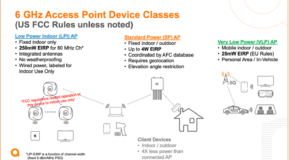
Getting past the hype around sustainable networking solutions can be daunting, and customers are often left sifting through data sheets and marketing claims to determine which attributes deliver the most sustainable IT benefits. Size and weight certainly affect the cost and ecological impact of transportation, just as power consumption affects the carbon impact of product operation over time. However, it is not merely the values themselves to consider, but the innovation that goes into the designs that drive the total power consumption and carbon footprint over time.
Most popular access points are based on AP reference designs created by chipset manufacturers. Generally speaking, the first reference designs released for a new chipset incorporate the highest power RF Front End Modules (FEMs) available, enabling the widest coverage area possible. While this works well to reduce the number of APs in environments with fewer clients running low bandwidth/non-latency-sensitive applications (such as retail scanners), it is less efficient in enterprise environments where more APs are needed to provide a higher quality of service to larger device populations operating voice, video, location tracking, and other bandwidth-intensive applications.
Of course, the RF power could be turned down to shrink the coverage area, but APs still communicate their maximum capacity to the PoE switches they are attached to. As a result, the switch can reserve the maximum power capacity for the AP in its budget allocation. Not only can this make the power utilization on the switch inefficient, the incremental cost for designing in high-power RF FEMs makes them less attractive, particularly for use in entry-level and mid-range access point designs.
One way to optimize power utilization for these APs is to design them with lower power RF FEMs. For such design programs, HPE Aruba Networking team leverages strong relationships with RF FEM vendors and chip set manufacturers to deliver mid-power RF FEMs that support performance and service delivery expectations and to tune reference designs so that these RF FEMs can be used with new reference designs.
Another way to optimize power utilization is to ensure efficient network operations. The more efficient the network, the less power is wasted by unnecessary traffic associated with packet loss, poor channel utilization, improper load balancing, and other network anomalies. HPE Aruba Networking Access Points have been designed with intelligent power management features that lower power consumption. Innovations that contribute to improved efficiency include:
- Ultra tri-band filters - HPE Aruba Networking uses an exclusive method of combining filters to enable use of entire 5GHz and 6GHz band without restrictions or performance degradation. Doing so offers up to 15% more channel choices, improving communication performance for all clients.
- AIC (Advanced IoT Coexistence) - Split band filtering on the 2.4GHz band allows Bluetooth and Wi-Fi to operate concurrently without mutual interference, which leads to fewer retransmissions on both wireless technologies and better network utilization.
- ACC (Advanced Cellular Coexistence) - HPE Aruba Networking pioneered the use of a sharp filter on the 2.4GHz radio, which affords better immunity to cellular band interference. This feature has been in place on Aruba APs for four generations, starting with the release of the AP-135.
- Smart PoE - All mid-tier and high-end AP products are built with a power combining/sharing feature. This enables customers to support new higher-power APs with existing PoE infrastructure, giving them the flexibility to extend the life of existing assets. The dual hitless failover feature allows use of redundant power sources on each port in critical deployments, where AP can continue operation in event of interruption on one of the power sources, eliminating downtime and maintaining overall network efficiency. Minimum Power Signature (MPS) is built into each port such that the redundancy feature does not consume more power to maintain two active power connections.
- Telemetry / IPM - HPE Aruba Networking has been using Intelligent Power Management (IPM) for several AP generations and has continued to refine its capabilities to provide a high level of telemetry reporting with better resolution. This function will actively manage features and performance based on available power source budget improving overall efficiency in system. The right amount of power and features can be balanced without overdesigning power supply or risk of downtime due to resetting.
It is also important to know how much energy the network is consuming. Today customers can find the average power usage of each of their devices on the AP Details page in HPE Aruba Networking Central. Multiplying the number of APs by their average power consumption gives customers a fair estimate of their network’s AP power consumption profile. Looking forward, we are actively working to expand this visibility to provide customers with additional capabilities to monitor and control their sustainable IT footprint over time.
Lifecycle management is also a critical component of sustainable IT. As a general practice, HPE Aruba Networking designs products to maintain high-performance in demanding environments. HPE Aruba Networking access points are also designed for reliability and longevity, with life cycles averaging 10 years. This means that products can not only operate for extended periods of time in an installation, but many times also be renewed for a second life once customers transition to a new technology set. Our products are also designed to maximize recyclability, and we incorporate components that will minimize the amount of material returned to landfill, such as low halogen PCBs, lightweight aluminum frames, zero heavy metals or ozone depleting components, to name a few.
HPE has the largest global technology renewal operations in the world, and we lead the industry in delivering full lifecycle asset management services to our customers that enable them to recover value, extend the lifecycle of decommissioned hardware, and measure the power and emissions savings that are generated by the responsible dispositioning of retired assets. Over the last three years, HPE has processed over 3.6 million assets, 90% of which were upcycled and returned to active use and returned $1.1B to our customers’ budgets to help fund their digital transformation projects.
While can be challenging to identify the specific product features that have the most impact on your sustainable IT profile, it is important to focus on the attributes that drive IT efficiency as well as the focus on continued innovation that will expand visibility and control of network resources. As a leader in driving sustainable practices for over 30 years, HPE has made investments in these areas and will continue to drive innovation that will help our customers improve their sustainable IT profiles and advance the way they live and work.




